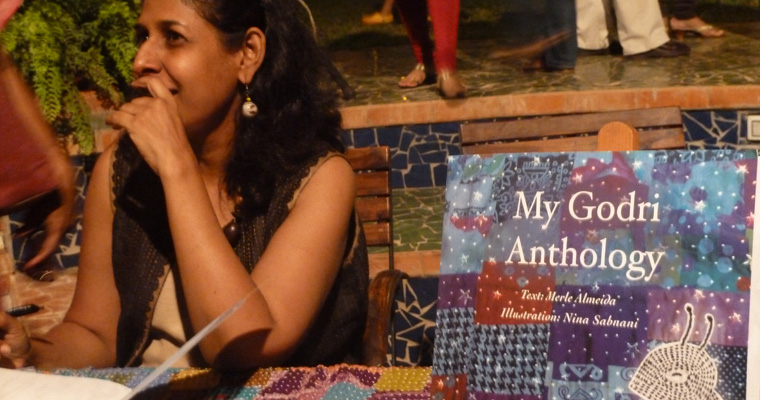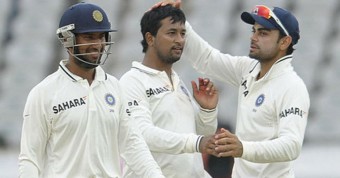Stories of a Woman’s Life
Here’s a chance to put your child to sleep with the calm of a grandmother’s quilt. So what if you don’t own one? You can now have My Godri Anthology, a graphic book penned by Merle Almeida, which aside from some very lovely reading makes an important contribution to the cause of preserving oral history in Goa.
In the book, Merle has transformed the oral tradition into verse with the story of her childhood memories. What’s more, artist Nina Sabnani has inimitably embossed Merle’s work in a graphic godri (quilt), literally, with drawings, fabric images and even a note from an old book she found at the house of Merle’s aunt.
The narrative in the 36-page book (priced at Rs 175) revolves around three characters – Merle’s grandmother Agusta, a 12-year-old girl and the ant ‘Anton’ to whom the girl tells the story.
Merle, of Goan origin but living in Mumbai where she works as an editorial consultant, believes that such translation of oral history into literary texts could spring hope for reviving, among today’s kids, certain traditions lost to the media explosion in the modern world.
So why is the book called ‘My Godri Anthology’?
The book, published by Bookworm Publishing, is essentially a patch-work of stories revolving around the author’s grandmother Agusta, just as patches and scraps of cloth make up a Godri (quilt). Merle’s mother died when she and her three siblings were young, so her grandmother lovingly stepped in and became a mother to them.
“A lifetime of coping made Agusta, like women through the ages, a survivor,” recounts Merle nostalgically. “What I find extraordinary now when I look back is her lack of cynicism. She liked life, laughed a lot, did not take herself seriously and thought her four granddaughters walked on water. She mothered so many more than she bore (thanks to the premature deaths of 4 women in her immediate family) with joy, food and the occasional enema!”
Merle’s grandfathers both sailed the high seas. Then came the First World War, separating Agusta from her husband for many years, early in the marriage. Those years came alive to Merle through oral accounts of her villagers.
“Our family did not lose anyone in WWII, but my uncles recall wailing in the village during the war, when they would know one more ship had gone down. Oral histories tell me that Assolna (village) lost several young men to WWII. I am not sure of casualties as far back as World War I – I know my grandfather survived a shipwreck early in his sailing career.”
Patches in the quilt of stories narrate these periods and how a young Agusta, in a revolt of sorts, lived in her own parents’ house, rather than at her mother-in-law’s. The eerie psychological scars she bore due to the loss of three children to infant mortality also echo in her book.
“This was so common at that time. Agusta lost three babies, all carried to full term, before Antonio, her fourth, survived. She believed that to be St Anthony’s 13th miracle! She mourned her lost babies till the end. She never knew why they died or why Antonio survived.”
Although her grandmother is at the heart of this graphic book, the narrative is also about other characters, mostly women, who Merle encountered during her schooling days, and in a lyrical way, tells the story of a Goan community of the 20th century.
“To me, the patches in the quilt represent comfort, cohesiveness and collective memory – in a tactile sense as well as more metaphorically, our patchwork quilts knit us together regardless of where we are in time or space,” reflects Merle.
The making of the book itself was again a collaboration between two women, Merle and Nina. A former senior designer at the National Instute of Design, Ahmedabad, Nina Sabnani, who had visited Goa in earlier years only as a tourist, spent two weeks in Goa to get to know the feel of the community and thus give graphic representation to Merle’s story.
“For me, using this ruse to tell this story was accidental.” Merle delves deep into the creation of the book. “For Nina, the designer and my partner in this book, it was fate. Nina believes that needlecraft is a conduit for community memory, that has given women a voice through the ages.”
“In this book, Nina has used needle art and craft from my family as well as neighbours and friends and their families, including Bookworm’s intrepid women. She delved into old cupboards, trunks, lofts, frames, albums, Goan history and anthropology to immerse herself into the story. We chatted over several months about many of the things discussed in this deconstruction! Also about Assolna, the Sal, about AVC (the Assolna-Velim-Cuncolim area) and its contentious relationship with power and with itself over centuries. Several months, 3000 photos and many, many pots of tea later, she put all her ethnographic research aside and went to work – visualizing and designing the book with astonishing speed and an intimacy I still find difficult to explain.”
This is the fourth book for children published by Bookworm, a library and activity centre dedicated to kids. Its publishing philosophy is to make literary texts about local oral traditions available for children. Their earlier books have been Bebeachem Kazar, an English translation of a poem by Manoharrai Sardesai; Bindi Su, a graphic book by Milan Khanolkar; and Once Upon A Feast, a graphic book by Mia Marie Lourenço and illustrated by Fatima Barot Mota.
Victor Rangel-Ribeiro, editor and the author of Tivolem, opines that a child could need help with this book. “Though the book is rich in graphic imagery, it will work better if a parent or other adult guides the child reader through the verses. The context of some of the cultural and historical allusions will need to be explained to a child.”
Sujata Noronha of Bookworm Publishing is reluctant to tag My Godri Anthology as a book for children. “That’s a rather reductionist view. We believe this book is for all ages, adults too are responding to these texts and images. I agree, a child below ten would need adult mediation to understand this book, but older kids and teenagers would be able to comprehend it on their own.”
My Godri Anthology is a bold experiment born out of love, and tells many stories. Perhaps it is just the first in a series of other graphic books that may emerge from other such author-artist collaborations. Books that take the world of tale and texture around us and enclose it between pages of paper.
.
.
.




